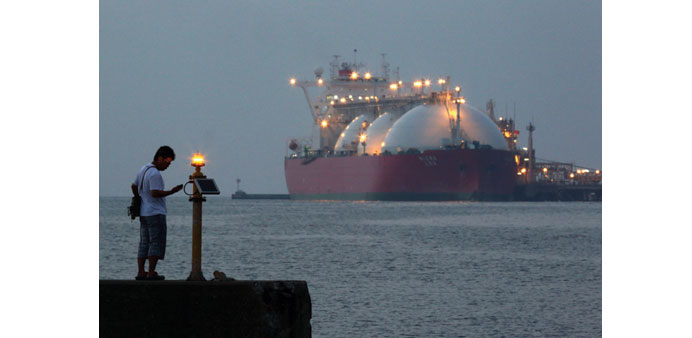A man looks at his smartphone while standing across from a liquefied natural gas (LNG) tanker berthed at Tokyo Electric Power Co’s (Tepco) Futtsu gas-fired thermal power plant in Futtsu, Chiba Prefecture, Japan. The cost of most American LNG shipments will be linked to the natural gas benchmark at Henry Hub, Louisiana, potentially making them cheaper than deliveries tied to crude prices, according to Cheniere Energy Inc, the company scheduled to ship the first US LNG cargo in January.
Bloomberg
Singapore
When the first cargoes of liquefied natural gas from the US sail next year for the global market, they’ll offer at least one incentive that may lure customers away from rivals.
While suppliers usually restrict the places to which the supercooled fuel can be delivered and don’t allow buyers to re-sell cargoes, US LNG is free from such destination clauses, according to an official at a unit of Japan’s Tokyo Gas Co. What’s more, the cost of most American shipments will be linked to the natural gas benchmark at Henry Hub, Louisiana, potentially making them cheaper than deliveries tied to crude prices, according to Cheniere Energy Inc, the company scheduled to ship the first US cargo in January.
Tokyo Gas predicts the supplies from US will be a “game changer” as cargoes free of destination clauses would offer more flexibility for buyers, Kunio Nohata, an executive at a unit of the Japanese company, said at the recent Gastech Conference and Exhibition in Singapore. Permitting customers to re-sell shipments may encourage buyers, sellers and traders to compete in a market similar to crude oil’s.
“Henry Hub has stayed lower and it’s back low and it’s here to stay at a low rate, which I think people will take into account when they look at the competitiveness of US LNG,” Andrew Walker, vice president of LNG strategy at Cheniere’s marketing unit, said on October 29.
Cheniere estimates the break-even price for its supplies from the Gulf Coast delivered to Asia would be $7.70 per million British thermal units to $8.40 per million Btu, according to an October presentation on its website. That’s lower than shipments from other regions including Northwest Australia, where the break-even price is as much as $16, according to the company.
US natural gas futures for delivery to Henry Hub have plunged 38% over the past twelve months. Spot LNG for delivery to Northeast Asia was at $7.10 through the week ended October 26, down 30% this year, according to data compiled from New York- based Energy Intelligence Group.
“We have more expectation with flexibility,” said Nohata, the president and CEO of Tokyo Gas Engineering Solutions. “In order to realise the demand, we need a competitive price.”
The share of US LNG in Tokyo Gas’ future purchases will probably rise to as much as 30% by around 2020, compared with about 12%-13% currently contracted, Nohata said. The Japanese company currently has deals to buy 1.9mn metric tonnes a year of supply from the US, he said.
US gas supplies boosted by the nation’s shale boom are poised to deluge global markets amid a global glut that’s dragged down prices. They’ll compete with cargoes from Australia to Qatar for market share as producers add a record amount of capacity next year while buyers in Asia demand more say in contract negotiations.
“While prices are low, the delta between the landing prices in Europe and Asia compared to Henry Hub are still big enough for the cargoes to be sold more economically and competitively in the region,” Amos Hochstein, special envoy and coordinator for international energy affairs at the US Department of State, said in an interview last month in Singapore.



